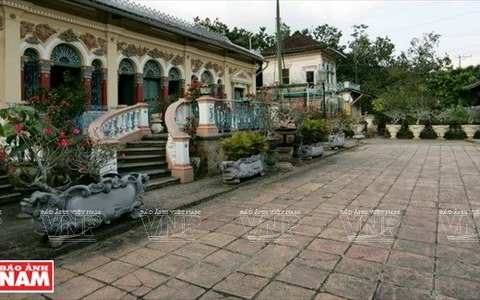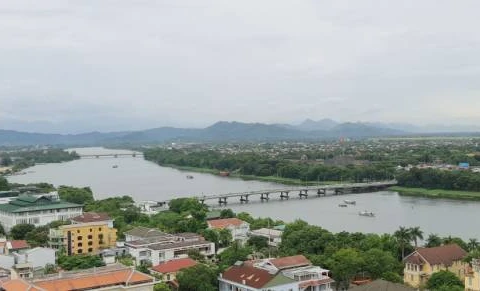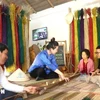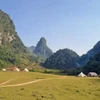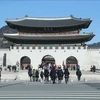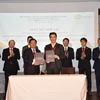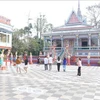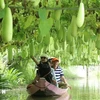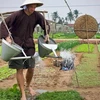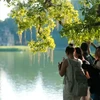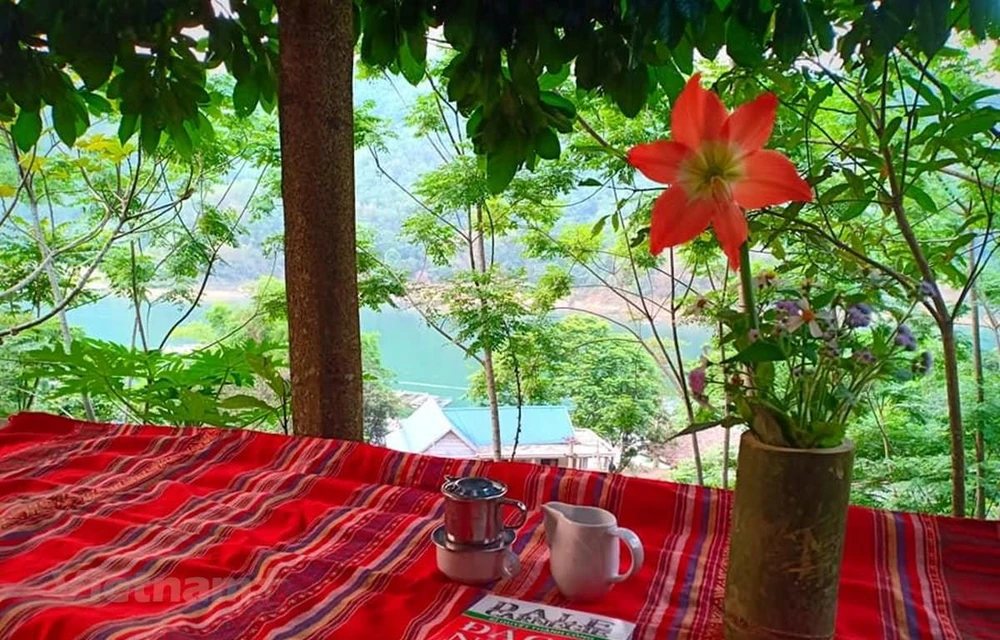
Hanoi (VNA) – After four years, homestay developers, especially women like Nhem, have learnt a lot to develop themselves and taken advantages of opportunities from the culture and specialties of the locality.
The morning in Da Bia village, Tien Phong commune, Da Bac district of northwestern Hoa Binh province was filled with birds’ songs and stunning mountainous landscape and view of Da River.
In March, hills were covered with red Bombaxceiba flowers. The road led us through hills like a miniature Ha Long Bay in the mountain, through maize fields and old houses. The children were excited to see strange visitors, while old ladies looked at us through the windows of their houses, smiling gently.
[Da Bac farmer success with community-based tourism]
Thanks to the project funded by the Australian Foundation for the Peoples of Asia and Pacific Limited (AOP) to support Da Bac develop community tourism, after four years, the face of the land has changed considerably.
From only one or two homestays, Da Bac now houses dozens of them, mostly in Da Bia, Ke and Sung villages, which has been standardized and become examples for other localities.
Untold stories
Recognising opportunities from community-based tourism as the number of tourists to Da Nac has increased, the family of Dinh Thi Nhieu (owner of QuangTho Homestay), borrowed money to develop their own homestay.
Nhieu said that having yet to recover the investment, she is still happy as tourism has given her chances to meet many people. The work is also lighter than agricultural activities.
Recalling her memories of the first days in tourism, Nhieu said that when receiving the first group of tourists, she was so worried that she could not sleep well. Before the visitors arrived, she and her husband spent the whole night sleepless. The shortage in capital and necessary skills was the greatest obstacle facing them then.
Locals in Da Bia, like Nhieu and Nhem, from zero understanding of community-based tourism, have now become confident to receive both domestic and foreign visitors. From limited skills in promoting tourism and a lack of board to serve tourists, now they have equipped themselves with all.
Everyday, Nhem scrolls her Facebook account to update the information of her homestay and post images of tourists exploring the mountain and river and enjoying local specialties. She is also confident in using English with foreigners, though sometimes she has to use her body language. Skillfully, she operates her homestay smoothly.
Another female manager of a homestay, Dinh Thi Thuy, who was once only good at farming, now can use Google to learn ways to decorate her homestay. Assisting her parents to operate the facility, Thuy has had opportunities to learn and meet more friends.
When “seeds” spread
Vu Tuyen, an AOP official, said that since August 2014, the project has provided 50 percent of loans with zero interest rate to four households in Hien Luong and Tien Phong communes of Da Bac to run homestays, while opening training courses for locals. The households will pay the debts with 30 percent of their monthly profit.
Over the past four years, the AOP has accompanied residents in Da Bia village in seeking customers and supervising tourism service quality by forming the Da Bac Community Tourism Company.
Coordinators from the company will divide tourist groups to all homestays so that the facilities can have chances to develop.
From the “seed” of Ngoc Nhem Homestay, Tien Phong commune is now home to many others such as Dinh Thu, Quang Tho, Lake View and Van Hieu.
Nhem said that the number of European visitors to her homestay is higher than that from domestic localities. In 2018, her homestay welcomed 155 groups of visitors, each with about 8-17 tourists. Many regional provinces have sent representatives to Da Bia to learn the tourism model, including those from Ha Giang, Dien Bien, Lai Chau, Yen Bai and Cao Bang.
Local residents like Nhem, after four years of providing community-based tourism services, have found that this is a sustainable development orientation.
“I am not satisfied yet. I will learn more to develop myself and my homestay as I understand that I cannot depend on the AOP support forever,” said Nhem.
After four years, homestay developers in Da Bac, especially women like Nhem, have learnt how to optimize opportunities from the local culture and specialties. They clearly understand what they want to become and what to do for themselves and the community, despite difficulties ahead./.
| The whole territory of Hien Luong and Tien Phong communes of Da Bac lie on the basin of the Hoa Binh Lake, giving them advantages in river eco-tourism as well as cultural and historical tourism, along with potential in aquatic sector’s development. The route along the two communes, combining waterway and road travelling, give visitors a panorama view of local landscapes and help them explore the daily life of people from ethnic minority groups such as Muong, Dao, Tay and Thai. Furthermore, from each commune, visitors can approach neighbouring tourism sites such as Mai Chau and Ky Son. The Ky Son-Da Bac-Mai Chau community tourism cluster is expected to become a highlight of Hoa Binh tourism in the future. |






